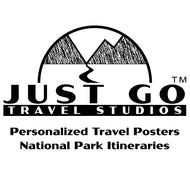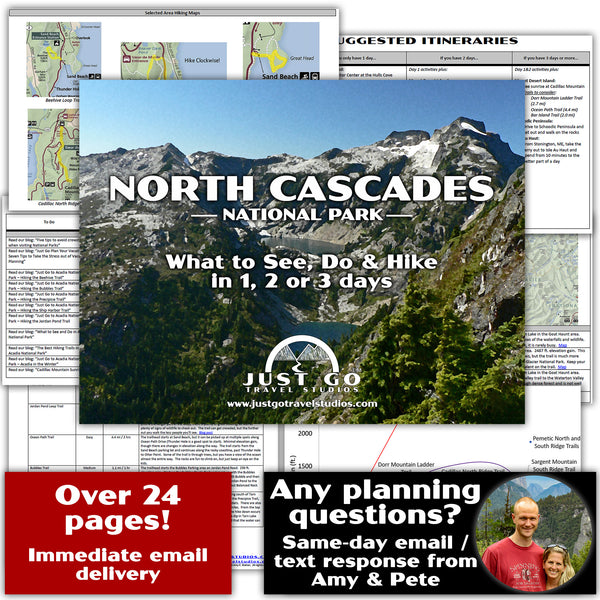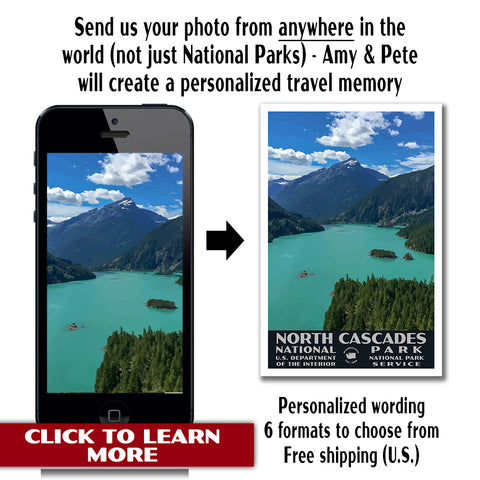North Cascades National Park isn’t particularly well known, let alone the Maple Pass Loop. Heck, we almost passed this hike up in favor of other, shorter trails inside of North Cascades.
What a mistake that would have been.
The Maple Pass Loop Trail ended up being one of our family’s most favorite hikes of all-time, and it remains as Pete’s #1 hike in all his 43 years of traveling.
Yes-it’s that good.
Join us as we take you through what you are missing if you don’t go on this hike, or what to expect as you plan for your trip. This is one of the best kept secrets in the National Park system and you’re going to love this amazing trail!
MAPLE PASS TRAIL DETAILS
- Difficulty: Strenuous
- Distance: 6.4 miles (round-trip)
- Trail: Loop
- Elevation gain: 2,442 feet
- Peak elevation reached: 6,971 feet
- Best time of year to hike: Mid-summer to fall
- To beat the crowds: Arrive before 8:00 am or after 3:00 pm
- Footwear: Hiking boots
- Watch out for: Mosquitoes, sun exposure
- Restrooms: At the trailhead, but none on the trail
- Pets: Not allowed
- Time needed: 4 hours
Things to do in North Cascades National Park, maps of North Cascades, what to pack before your trip and useful links are covered in our extensive itinerary for North Cascades National Park. This downloadable guide will help you get your trip planning started and take much of the guesswork about how to spend your time!
PARKING AND TRAILHEAD FOR THE MAPLE PASS LOOP / MAPLE PASS TRAIL
The trailhead for the Maple Pass Trail is located at the Rainy Pass Trailhead on Highway 20. This is the main highway that travels through North Cascades National Park, between the towns of Concrete (to the west) and Twisp (to the east).

Rainy Pass Trailhead Parking Area

Since lodging and camping inside of the park are extremely limited, it’s likely that you’ll have to drive a fair distance from wherever you are staying to get here. From the east, a common town to stay in is Omak, which is located about 1:35 from the trailhead.
- Directions from Omak to the Rainy Pass Trailhead can be found here. From the west, one common places to stay includes the area around Burlington, WA.
- Concrete, which is the western entrance to the park, is about 1:30 from the trailhead, and directions from Concrete can be found here.
If you are want to camp, there are several options to the west that you can find in our blog on campgrounds in North Cascades National Park.
There are over 50 parking spaces available in the lot. While this may seem like a lot, parking can fill up fast. We arrived just before 8:00 am and got a spot easily. However, cars were piling in fast. When we returned from our hike later in the day, it was clear that parking had been a challenge for most of the day. Even at 2:00 in the afternoon, cars were arriving and having trouble finding a spot. There were also plenty of cars parked on the highway. People also were fairly creative as to what they deemed acceptable for a parking spot too, with cars squeezed into places that weren’t really designated for parking.
There were clean pit toilets available at the trailhead.
MAPLE PASS LOOP: TRAIL SURFACE AND ACCESSIBILITY
- Trail surface. The trail is packed dirt for most the hike. As you get higher up and more exposed, you may find yourself having to hike on snow. If you are going before mid-July, you can count on it, and it may be impassable. Microspikes can help, but may not be necessary if there is only a bit of snow.
- Accessibility. This trail is not wheelchair accessible or suitable for hikers who are not sure on their feet.

Maple Pass Loop Trail Route
WEATHER AND FEES FOR THE RAINY PASS TRAILHEAD / MAPLE PASS LOOP
One of several types of passes are required to park at the trailhead, and those passes can be obtained at the trailhead (or online). Passes accepted include the National Park Pass and the Northwest Forest Pass.
The Maple Pass tops out at 6,971 feet, which means that it gets a lot of snow. Storms can be rough here, and even hikes here in the early fall can be stopped prematurely with heavy snowstorms. Also, the snow doesn’t melt well into July. For the latest information on trail conditions, check the North Cascades Trail Conditions site.
Finally, trails are not maintained in the winter, as trail crews are sent elsewhere in the country during this time of year.
Our thoughts? If you aren’t hiking in July, August or September, you should be prepared for any type of weather or trail conditions.
We took to the trail in mid-July, and the conditions were nearly perfect.
PREPARATION FOR HIKING THE MAPLE PASS LOOP TRAIL
The Maple Pass Trail is incredible, but you need to make sure you are prepared. We were lucky when we went in that the weather was fairly consistent for the entire hike, but it really can vary widely. Here are a few things to consider ahead of your trip:
- Water. It can be very dry in the mountains, even though you may be surrounded by snow. We recommend bringing with you a large water bottle or a hydration pack.
- Sun Protection. Please don’t forget to put on plenty of sunscreen, especially as you get to the exposed areas and where the sun can beat off the snow.
- Trail map. We’ve found the National Park maps to be a bit lacking for this park. It’s really useful to have a great hiking map with you, and our go-to-map for North Cascades National Park is the North Cascades National Geographic map.
- Microspikes. It may seem a bit like overkill, but it’s likely that if you hike here even in July that you are going to encounter snow. Some of the snow may be packed and quite slippery, so having the confidence of microspikes on you can be the difference between having to turn back early and finishing the entire hike.
HIKING TO MAPLE PASS
After doing some research, we decided to hike the loop in the clockwise direction. We understood this to be the less popular route, but for us the attraction was getting the steep part of the trail on the uphill rather than having our knees take the stress of the steep downhill. We also heard that the trail views were more spectacular in this direction, though after experiencing the trail ourselves, we think that hiking in either direction would be phenomenal.

We started by taking the Rainy Lake Trail to the south (by turning left from the parking area). The Rainy Lake Trail is shared with the Maple Pass Trail for the first 0.3 miles before splitting from one another. The Rainy Lake Trail continues another 0.5 miles to Rainy Lake, but we decided to not add this to our hike and just took a right and headed up the Maple Pass Trail.

Immediately after the split, the Maple Pass Trail starts to ascend. Though not the steepest trail we’ve ever taken, the climb is steady and continues for the next 2.1-miles so it does get tiring.

For the first mile of the climb, we were covered in a forest canopy. Switchbacks helped ease the ascent.

After about half of the two-mile climb was behind us (or 1.3 miles since the start of the trail), there was an overlook to Rainy Lake. Though not a formal stop, this is a great place to relax a bit before continuing the journey. There were several waterfalls rushing into Rainy Lake which were absolutely incredible. The largest was Rainy Lake Falls, which is actually a series of falls that drops over 850 feet in total height.


It was at this stop that we saw the first hikers on the trail (since most of the other hikers that started at the same time went in the counterclockwise direction).
After the Rainy Lake overlook, the trail opens up alongside the mountain on the way to the pass. We enjoyed getting above the tree line and seeing the mountains open up.



Of course, we couldn’t resist taking some photos of the local wildflowers that had just started blooming after the snow melt.





MAPLE PASS
I still get goosebumps thinking about our time up on the pass. Don’t get me wrong, the hike up was breathtaking. But once we were at the pass, it was hard to know where to look since views in all directions were picture-worthy.


We stopped and rested here, proud of ourselves after completing the 2,100+ feet of climbing. It was at this point that we first entered North Cascades National Park-our 31st park we’ve visited as family. The rickety sign leaning up against a couple trees made the accomplishment even sweeter, as we knew that few got to enter the park this way!

We spent about 30 minutes up at the pass, enjoying our lunches and conversations with other equally amazed hikers.
HIKING FROM MAPLE PASS BACK TO THE RAINY PASS TRAILHEAD
The hike from the pass back to the trailhead is nearly 4 miles long, and the climb is about half as steep as it was on the way up.

Immediately after the Pass, the trail starts to descend. We actually came across more snow on this side of the Pass than on the way up, and in some cases we wished that we had Microspikes to help us out with our footing. Nobody slipped, but some extra grip would have been nice. Reading the forums, most people have them handy if they are hiking in the early summer or when snow might be present other times of year.



After descending for about 1.4 miles, Lewis Lake is barely visible (to the west), but it was too far for us to capture any good pictures. Lake Ann can be seen during most of the trip down.


About 1.2 miles from the parking area there is a 0.5-mile trail that leads to the shores of Lake Ann.

The trail back is easy compared to the climb. Most of the trail on the way back is exposed, so sunscreen is recommended. In some places it’s easy to see signs of previous avalanches and rock slides. We were lucky enough not to have to deal with any of those, though we did have to climb over a tree that was blocking the trail!

On the way down, we crossed paths with a ton of other hikers. Though the trail wasn’t crowded, we realized that we were lucky to only share the pass with one other group while we were up there!
MAPLE PASS LOOP TRAIL: TOP LIKES AND DISLIKES
Likes:
- This trail had breathtaking scenery. I mean, it was absolutely incredible once you got through the forest.
- Lack of crowds. We were able to get on the trail fairly early in the day, which meant we had the trail to ourselves for much of the way up. Hiking this trail without crowds is definitely preferred.
- The mountain wildflowers on this hike were unlike any other park we’ve encountered before. The contrast of the color against the mountain landscape was something to see!
- The journey. Yes, the peak was the highlight, but the journey along the way was great as well. Our family loved the entire hike and at no time did it seem like a slog.
Dislikes:
- Shaky footing. Though it’s hard to come up with “areas of improvement” for this hike, the biggest area that caused us concern on the hike was the snow. If you are prepared with hiking poles or microspikes, you should be all set.
- Weather. The Maple Pass Loop is a hike that you will love, but no matter what time of year you are going, you are going to have to be prepared for unpredictable weather. Ahead of the hike you’ll want to check recent hiking reports to see the status.
FINAL THOUGHTS
- The trail was well groomed and we never felt we were unsafe. There was a stretch on the way up that was along a ridge line that was a bit scary for some other hikers that we shared the trail with. Our kids never gave it a second thought, but if you are afraid of heights, you’ll just want to be mentally prepared. Don’t worry, though! It isn’t bad at all.
- Make sure you pack plenty of water and maybe a jacket for your trip. It’s easy to get dehydrated on the hike, and the top can get cold (and will most certainly be windy!).
- We were able to take this hike in the morning and finish up the rest of the day driving through the park. There was plenty of time to see what we wanted to see along the park highway, though if you want to stop and take additional hikes you would likely need at least another day in this part of the park, or a few days if you plan on really exploring the park.
FURTHER INFORMATION ON NORTH CASCADES NATIONAL PARK FROM JUST GO TRAVEL STUDIOS
- We’ve put together over 14 pages of information on all there is to see and do inside of North Cascades National Park. This downloadable itinerary includes maps for North Cascades, information on the best things to do, where to stay nearby North Cascades, tips on what to pack and what else to see when you are in the area. We also have a thorough blog on North Cascades Campgrounds to help you plan you where you will be staying if you like to camp.
- A quiet spot in this quiet park is Lake Chelan. Be sure to view our blog on Hiking in Lake Chelan to see if this corner of the park is right for you!
- As you can tell, the Maple Pass Loop was incredible, and it’s why it was featured as one of our top-rated hikes in U.S. National Parks with breathtaking views.
- When you get back, check out our process that we use when creating vintage-style travel posters from photos sent to us by our customers. We’ve created more than we can count, and would love to work with you to help you remember your vacations forever.
OTHER USEFUL LINKS ON NORTH CASCADES NATIONAL PARK AND THE SURROUNDING AREA
- Just to the east of the hike on Route 20 is the town of Winthrop, Washington. This is a great place to explore as well. Mountain biking in the area is very popular.
- Adam and Kathryn have a terrific blog post on their Favorite Hikes in Washington. Maple Pass was one, but check out the others that are on their list for a bunch more great ideas.
- We visited the park in the summer, but if you want to know a bit about how to get the most out of North Cascades in the fall (spoiler-it’s beautiful!), check out Sonja’s blog on Visiting North Cascades National Park in the fall.
- Astrid (from The Wandering Daughter) lists 7 easy hikes in North Cascades National Park and covers them in detail in her blog post: Seven Easy Summer Hikes in North Cascades National Park.
- Tara (from Backroad Ramblers) put together a terrific post on an overview on North Cascades National Park.





